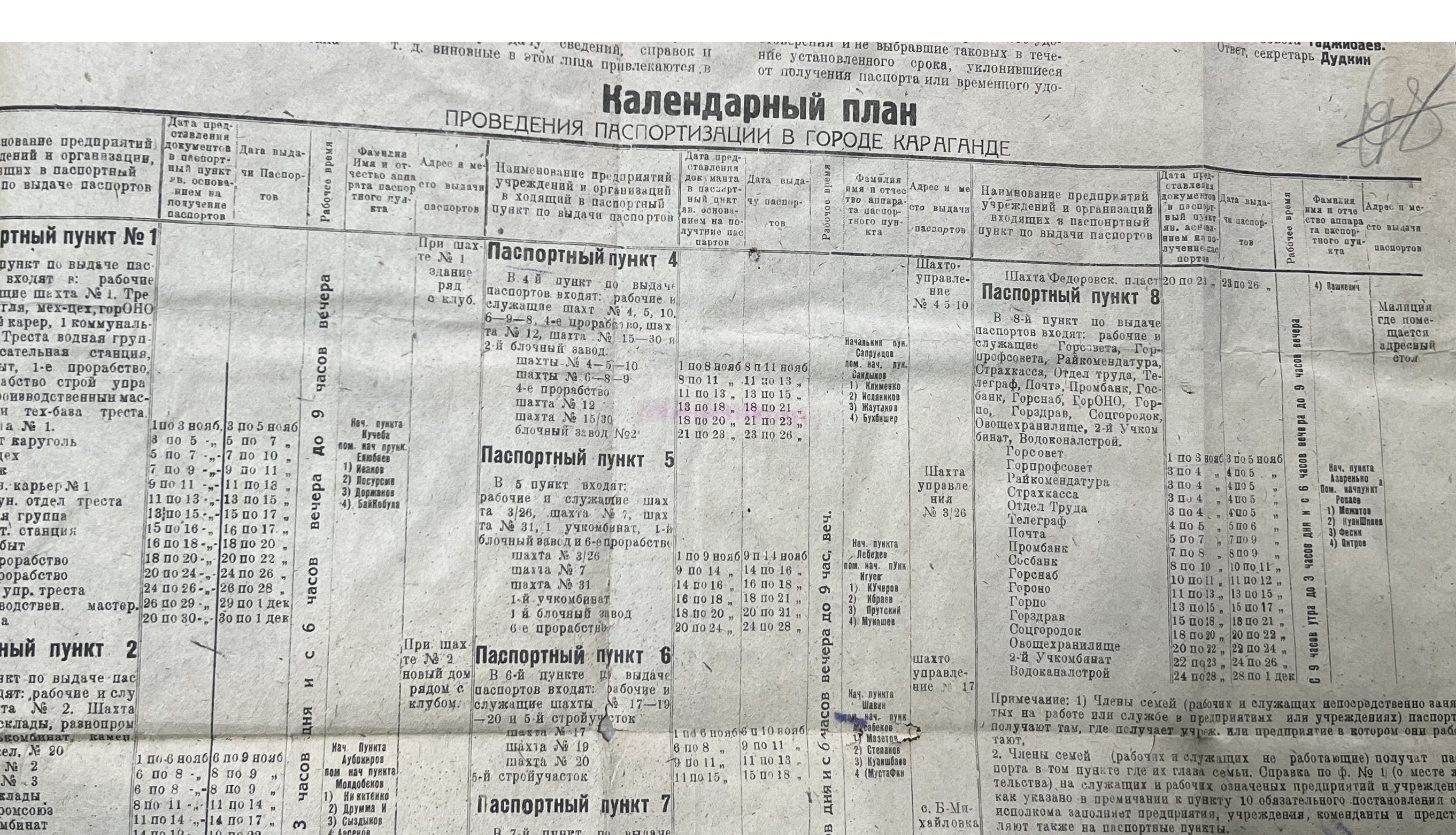Formation of the Passport System in the Karaganda Region during the 1930s
Research article
Views: 140 / PDF downloads: 56DOI:
https://doi.org/10.32523/3080-129X-2025-152-3-186-207Keywords:
KASSR, Karaganda region, passportization, registration, segregation, socially alien element, identity document, seasonal migration, militiaAbstract
This study presents an institutional and socio-historical analysis of the formation of the Soviet passport system with particular focus on its implementation in the Kazakh Autonomous Soviet Socialist Republic (KASSR), specifically in the Karaganda region, which held strategic importance in the USSR’s plans for industrialization and labor mobilization. The introduction of a unified passport system in 1932 became part of a sweeping bureaucratic transformation of the Soviet state aimed at comprehensive demographic registration, filtration of migration flows, and population selection based on labor utility. Drawing on archival materials‒including documents from GASKO, GAKO, RGASPI, and GARF—the research traces the normative evolution of the passport campaign and its local mechanisms of execution. Marked by rapid industrial growth, the establishment of camp infrastructure (Karlag), and influxes of special settlers and spontaneous migrants, the Karaganda region emerged as a site for experimental implementation of registration and control policies. Even prior to the official launch of passportization, schemes of registration, address bureaus, fees for residence permits, temporary identity documents, and sanctions against the “nonproductive element” were developed. The study illustrates how administrative acts and local council resolutions materialized into operative models of control: alphabetized registration, appointment of commandants, paid residence registration, and enforcement of penalties for non-compliance. Special attention is paid to the social stratification caused by the division between “passport holders” and the “passportless,” the latter effectively excluded from legal frameworks and deprived of access to employment, housing, and mobility. The work reveals the repressive capacity of the passport system: arbitrary arrests, denial of documents based on social status, delays in issuance, and citizen complaints to the prosecutor’s office. Passportization appears not only as a tool of registration but also as a technological instrument of governance impacting identity, citizenship status, and social mobility. The analysis suggests that the passport system operated as a mechanism of political-administrative segregation: separating the population into “documented” and “undocumented,” with the latter losing access to housing, labor, and legal recognition. Repressive elements were accompanied by normative adjustments, including exceptional cases of passport issuance as a reward. In conclusion, the experience of the Karaganda region reflects the structural contradictions of Soviet passport policy, which blended modernization ambitions with exclusionary and disciplinary practices under conditions of authoritarian industrialization. Thus, passportization in the KASSR emerges as a phenomenon uniting the goals of modernization with instrumentalized mechanisms of exclusion. The study uncovers the administrative logic of total surveillance and local variations of implementation amid authoritarian industrial expansion.
Downloads
References
Potapova N. Soviet Migration in the Context of Passportization in the Early 1930s. Gumilyov Journal of History. 2025. Vol.151, no.2, pp.63–80. https://doi.org/10.32523/3080-129X-2025-151-2-63-80 (in English) DOI: https://doi.org/10.32523/3080-129X-2025-151-2-63-80
Shearer D. Elements Near and Alien: Passportization, Policing, and Identity in the Stalinist State, 1932–1952. The Journal of Modern History. 2004. Vol.76(4), pp.835–881. (in English) DOI: https://doi.org/10.1086/427570
Torpey J. The Invention of the Passport: Surveillance, Citizenship, and the State. Cambridge University Press: Cambridge, New York. 2000. 211 p. (in English) DOI: https://doi.org/10.1017/CBO9780511520990
Ablazhei N., Zhanbossinova A., Potapova N. Pasportizatsiia v Kazakhstane v 1932–1940 gg.: istoriografiia, istochniki i algoritm kampanii. Bulletin of KarGU. Series “History. Philosophy”. 2025. No.301(117), pp.39–53. https://doi.org/10.31489/2025HPh1/39-53 (in Russian) DOI: https://doi.org/10.31489/2025HPh1/39-53
Arestov A., Ivanova L. Administrativno-pravovoi mekhanizm pasportno-registratsionnogo i migratsionnogo ucheta. Moscow: Book Laboratory. 2011. 174 p. (in Russian)
Bayburin A. Sovetskii pasport: istoriia – struktura – praktiki. St. Petersburg: European University Press. 2017. 488 p. (in Russian)
Izmeneniia pasportnoi sistemy nosiat printsipialno vazhnyi kharakter». Kak sozdavalas i razvivalas pasportnaia sistema v strane. Bulletin of the Archive of the President of the Russian Federation. 1997. No.6(31), pp.101–121. (in Russian)
Genrikh Iagoda: Narkom vnutrennikh del SSSR. Generalnyi komissar gosudarstvennoi bezopasnosti.: Collection of Documents. Eds.: Vinogradov V. et al.; Scientific Editor: Litvin A. Kazan. 1997. 535 p. (in Russian)
Zhanbossinova A. Formirovanie pasportnoi sistemy v Alma-Ate v 30-e gody KhKh veka. Bulletin of History. 2025. No.2(117), pp.20–32. https://doi.org/10.26577/JH2025117202 DOI: https://doi.org/10.26577/JH2025117202
Zakony SSSR 1917-1992 gg. (Accessed on March 30, 2025). https://economics.kiev.ua/index.php?id=582&view=articles (in Russian)
Ivanova L. Institut pasportno-registratsionnogo i migratsionnogo ucheta grazhdan Rossiiskoi Federatsii, inostrannykh grazhdan i lits bez grazhdanstva v Rossiiskoi Federatsii. Abstract of Dissertation for the Candidate of Legal Sciences. Moscow. 2009. 28 p. (in Russian)
Krasilnikov S., Teplyakov A. Nachalnik spets(trud)poselenii Zapadnoi Sibiri Ivan Dolgikh: nomenklaturnyi vzlet i vyzhivanie kadrovogo okhranitelia (1930-1937). Tomsk State University Journal. History. 2022. No.79, pp.64–73. (in Russian) DOI: https://doi.org/10.17223/19988613/79/8
Malygin A., Tarasov A. Pasportnaia sistema sovetskogo gosudarstva: stanovlenie i evoliutsiia. Ruza: Moscow Regional Branch of Moscow University of the Ministry of Internal Affairs of Russia. 2012. 286 p. (in Russian)
Tarasov A. Pasportnaia sistema i pasportnyi rezhim v sovetskom gosudarstve v 30-e gg. KhKh v. Dissertation for Candidate of Legal Sciences. Moscow. 2005. 166 pp. (in Russian)
Fitzpatrick S. «Pripisyvanie k klassu» kak sistema sotsialnoi identifikatsii. Russia and the Modern World. 2003. No.2, pp.133–151. (in Russian)
Fitzpatrick S. Sryvaite maski! Identichnost i samozvanstvo v Rossii KhKh veka. Moscow: ROSSPEN. 2011. 373 p. (in Russian)
Chernolutskaya E. Prinuditelnye migratsii na sovetskom Dalnem Vostoke v 1920-1950-e gody. Vladivostok: Dalnauka. 2011. 512 p. (in Russian)
Chernolutskaya E. «...V poriadke pasportnogo rezhima»: massovye kampanii vydvoreniia «neblagonadezhnykh» grazhdan s Dalnego Vostoka SSSR v 1930-e gg. Bylye Gody. 2013. Vol.27, no.1, pp.71–78. (in Russian)
Shlyakhtina N. Otnoshenie k nishchim gosudarstva i obshchestva v sovetskoe vremia. Scientific Orthodox Journal “Tradition and Modernity”. 2020. No.24, pp.40–62. (in Russian)
Khmelnytsky D. Stalinskii pasport. Uchet-prikhod-podschet: kak stroilos sovetskoe gosudarstvo. 2018. Available at: https://gefter.ru/archive/25308. Accessed: March 20, 2025. (in Russian)
Yunge M., Binner R. Ot «sotsialno blizkogo» do «sotsialno opasnogo» elementa: prestupniki i sotsialnaia chistka sovetskogo obshchestva. 1918-1938 gg. Stalinizm v sovetskoi provintsii: 1937-1938. Massovaia operatsiia na osnove prikaza No 00447. Moscow: ROSSPEN. 2009. 928 p. (in Russian)

Published
Issue
Section
License
Copyright (c) 2025 Ye. Sailaubay, К. Alimgazinov

This work is licensed under a Creative Commons Attribution-NonCommercial-NoDerivatives 4.0 International License.














